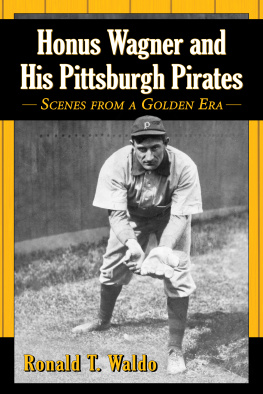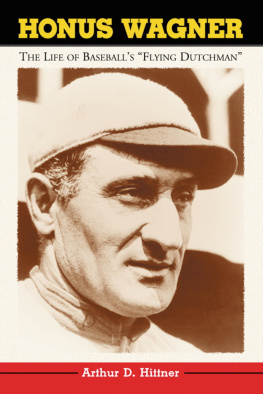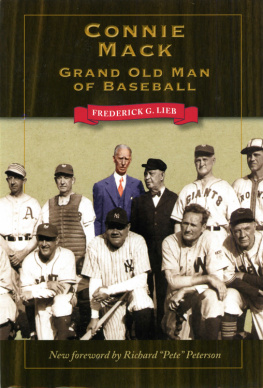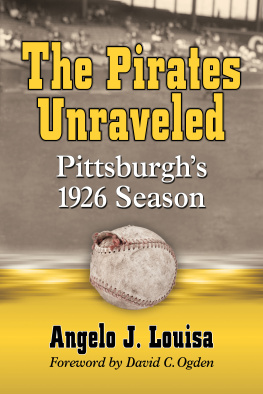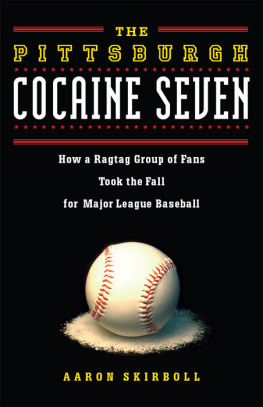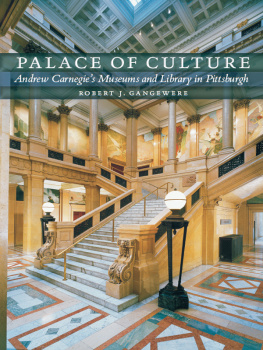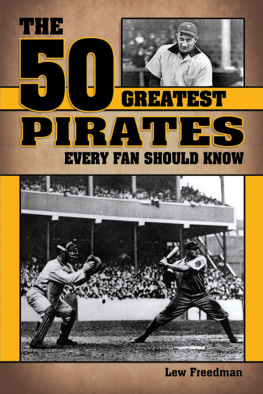
Also by RONALD T. WALDO
AND FROM MCFARLAND
The 1902 Pittsburgh Pirates: Treachery and Triumph (2015)
Pennant Hopes Dashed by the Homer in the Gloamin: The Story of How the 1938 Pittsburgh Pirates Blew the National League Pennant (2013)
Hazen Kiki Cuyler: A Baseball Biography (2012)
The Battling Bucs of 1925: How the Pittsburgh Pirates Pulled Off the Greatest Comeback in World Series History (2012)
Fred Clarke: A Biography of the Baseball Hall of Fame Player-Manager (2011)
Honus Wagner and His Pittsburgh Pirates
Scenes from a Golden Era
Ronald T. Waldo

McFarland & Company, Inc., Publishers
Jefferson, North Carolina
LIBRARY OF CONGRESS CATALOGUING DATA ARE AVAILABLE
BRITISH LIBRARY CATALOGUING DATA ARE AVAILABLE
e-ISBN: 978-1-4766-1882-1
2015 Ronald T. Waldo. All rights reserved
No part of this book may be reproduced or transmitted in any form or by any means, electronic or mechanical, including photocopying or recording, or by any information storage and retrieval system, without permission in writing from the publisher.
On the cover: John Peter Honus Wagner, Pittsburgh shortstop, National League, ca. 1911 (Library of Congress)
McFarland & Company, Inc., Publishers
Box 611, Jefferson, North Carolina 28640
www.mcfarlandpub.com
Acknowledgments
While I always strive in my books to give the best, most accurate representation possible of a particular player or time in baseball history, the efforts of others help make it possible for me to achieve that goal. This book about Honus Wagner and his era is no exception in that respect.
Securing permission to quote from articles that do not fall within the public domain is critical for baseball historians, since few things we can say about our subjects will bring it to life in quite the way that first-hand accounts can. I would therefore like to say thank you to Linda Parker, administrative assistant to the editors at the Pittsburgh Post-Gazette, and John Turner, deputy editor of The Sporting News, for their help during the permissions-gathering process. The coverage of Wagner and the Pirates in these two publications was indispensible to me, and the book is better for its quotations from them.
I would also like to thank photo archivist John W. Horne, Jr., of the National Baseball Hall of Fame Library for all of his assistance with the photos for the book. John always responded to my queries in a timely fashion, and the Hall of Fames photo offerings were unfailingly good. The diligent efforts of Horne, Jenny Ambrose and Pat Kelly over the years have in fact made what can be one of the more onerous chores an author facesfinding the right photos and arranging for their permissionsa fairly straightforward and painless proposition. These photos have offered a vital visual component that beautifully complements the written word.
Lastly, I want to say thank you to all of the people who read my books and articles. I love writing about baseball history and am extremely happy that people enjoy reading about forgotten baseball eras that helped define the game.
Preface
One of the beautiful things about the game of baseball is that its rich history and abundant heritage remain relevant today, more than a century after a new era dawned when men like Christy Mathewson, Nap Lajoie, Cy Young and Ty Cobb rose to the level of diamond icons. These baseball greats and the teams they played for defined that era as the game experienced a grand transformation that allowed it to grow and thrive. Baseball quickly rose to the stature of Americas Game as passionate fans across the country fell in love with this sport that was a combination of beauty and physical prowess. Players who performed on the diamond during the first two decades of the twentieth century were true pioneers who helped to build baseball into the great game that it still is today.
If men like Mathewson, Lajoie, Young and Cobb were the modern games founders and builders, John Peter Honus Wagner was the necessary forged steel that was critical in this entitys construction. A native of the nearby municipality of Carnegie, Wagner was the undisputed top player in the National League while he played for his hometown Pittsburgh Pirates in the Steel City from 1900 through 1917. Many also deemed Wagner to be the eminent star in baseball when compared to other players from that era. Even today, Wagner is still considered the premier player in Pirates history, the greatest shortstop in baseball history and one of the top players who ever set foot on a diamond. The fact that Honus Wagner is still viewed in this manner almost a century after he played his final major league game in 1917 is due in large part to an enduring legacy that has continued to live and breathe for decades following his death in 1955.
There are many reasons why Wagner continues to have a lasting legacy during our generation. Statistics such as the eight batting titles, playing for four National League pennant winners and smacking 3,420 career hits certainly help him remain relevant today. Excellent biographies chronicling moments and events from his career have also contributed to keeping Wagners memory alive. A third reason why Honus Wagners legacy has endured is due to the time-tested practice of stories being related and passed down through the ages. Baseball has always been unique in respect to its history remaining vibrant due to tales that have been shared through generations from grandfather or grandmother, to father or mother, to child.
I believe it is important to present a narrative that examines Wagner not only as a ballplayer, but also as a man. Through the use of a large collection of stories from Wagners time as a player and coach, which spanned 40 years, I decided to paint a picture that focuses on the climate of that baseball era as well as his personal achievements. Stories related to Wagner, his teammates and opposing players are presented in order to chronicle both that baseball era and that time period in American history.
Many of these stories are Honus Wagners reflections about baseball during his illustrious career, while some are the words of teammates and others who knew him. While a large majority of this material examines the interaction between Wagner, his teammates and other players on the diamond, baseball is not the entire subject probed in this work. I went to great lengths to include many examples of Wagners other pleasures in life such as fishing, hunting and going for long rides in an automobile. The underlying points regarding his selfless approach to life and the unique camaraderie that existed during that baseball era also come to the forefront in this book.
My approach in this book differs from others I have written. As someone who is fascinated by the little-known tales surrounding baseball, I wanted to immerse myself in a project about Honus Wagner, but not by writing a biography. Wagner is the subject of a couple of good ones already. The idea was instead to focus on events from the great players career as described by Wagner and his contemporaries. Since reporting players anecdotes about the game was one of the best advertising methods that existed when Wagner played, a wealth of information was at my disposal. Although Wagner often tried to avoid the limelight, he did become more comfortable talking about the game as the seasons went by. He transformed from a man who was reluctant to talk about baseball into an avid storyteller who wrote or co-authored many newspaper articles.
Next page
